The Gospel of Mithras
Eclipsed as it was in later centuries by the faith of Christ, Mithraism – or rather, its Romanised form Sol Invictus – was the first ‘universal religion’ of the Greco-Roman world.
Mithraism waged – and lost – a three-hundred year battle with the upstart religion of Christ, into which much of its ritual, and many of its practitioners, were subsumed. Fatally, Mithraism had excluded women entirely, causing well-heeled Roman matrons with a pious frame of mind to explore first Judaism, and then Christianity. Also, unlike Christianity, Mithraism made no special overtures towards the uneducated, downtrodden and marginal elements of society. Rather like an early day freemasonry, Mithraism was a religion chosen by the accomplished and the socially ambitious.
No wonder Christianity saw Mithraism as an implacable foe and sought to eradicate every trace – the Mysteries of Mithras was disturbingly similar to the cult of Christ.
Mithraism and its evil sibling – Christianity
“Parseeism had made a very distinct impression on Judaism in its formative stage.“
– Cumont, Mysteries of Mithras, iv.
Christianity essentially drew on the fables of Judaism for a template for its saviour. But Judaism, as a result of conquest and exile – like Mithraism – had also been fashioned by the religious mores of Mesopotamia. Judaism had been refined and developed in a Persian world. Here, for example, Judaism acquired its creation stories: of mankind’s descent from a single couple (for Mashya and Mashyana read Adam and Eve); a repopulating of the earth after an earlier destruction; a lawgiver (Zarathustra/ Moses), given commandments from a supreme god. Here, too, the Jews aquired their Satan, an evil force like Ahriman, a deceiver active in the world but predestined to ultimate defeat. Following a final judgement day, resurrection and life eternal would be the reward of the righteous.
In the Mithraic development from Zoroastrianism, Mithras personified light and justice. The righteous devotees were rewarded with success. In its Jewish offshoot, light and justice were represented by a future messiah. In consequence, the Christ cult that emerged from Judaism bore many resemblances to a kindred faith, Mithraism, not through vulgar “copying” but as the corollary of a common ancestry, filtered through diverse, but neighbouring, cultures. The similarities are stark and undeniable.
The Gospel of Mithras
“The Mithras Liturgy manifests a syncretistic piety that makes use of astrology and magic in order to provide a liturgical spell for the ecstatic ascent of the soul to God.“
– Meyer, The Ancient Mysteries, A Sourcebook, 211. (Great Magical Papyrus of Paris).
“As far as we can tell, cults such as Mithraism had no equivalent of the Council of Nicaea to determine their orthodoxy. The same deity might be subject of different, contradictory myths or the focus of different types of ritual at different shrines or cities.”
– K. Butcher, Roman Syria, p336
In a cave near Neuenheim, Germany, a particularly fine relief of the Mysteries of Mithras managed to survive the centuries of Christian vandalism. Discovered in 1838, the monument illustrates several scenes from the “life of Mithras”. Although the precise theology of Mithraism remains opaque, and is obscured by astrological references, from this story in stone, and supplemented by finds from elsewhere in Europe, we can build a reasonably detailed, albeit conjectural, “gospel of Mithra”.
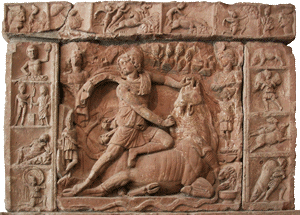
Miraculous Birth of a Saviour God
“And when those who record the mysteries of Mithras say that he was begotten of a rock ...”
– Justin Martyr, Dialogue with Trypho, 70.
Mithras’s supposed creation had occurred in a time before men. It had been a cosmic event in which, like Christ, Mithra had been fathered by a supreme, creator god (in his case, Ahura-Mazda). His birth, also like that of Jesus, had been a miraculous departure from the human norm but rather than birthed to a virgin, Mithras was said to have been released or “born of a rock”. This association of a god with rocks or stones is not surprising: fiery rocks falling from the sky and even sparks released by colliding stones would equally strike the pre-scientific mind as evidence of a godly presence.
The iconography of the rock womb of Mithras – the petra – was central to each Mithraic temple (Mithraeum). In several extant examples, Mithras is seen emerging naked from his rock (by some interpretations, the cosmic egg), often holding, in his left hand the world, and in the right hand, a dagger. The young god is a militant, not a passive, defender of righteousness.
The birth of the Unconquerable Sun Mithras was celebrated annually as the climax of the mid-winter Saturnalia festival, on 25th December.
“If the Mithraic mysteries were indeed a Satanic copy of a divine original, we are driven to conclude that Christianity took a leaf out of the devil’s book when it fixed the birth of the Saviour on the twenty-fifth of December; for there can be no doubt that the day in question was celebrated as the birthday of the Sun by the heathen before the Church, by an afterthought, arbitrarily transferred the Nativity of its Founder from the sixth of January to the twenty-fifth of December.“
– Sir James Frazer, The Worship of Nature, 1.526.
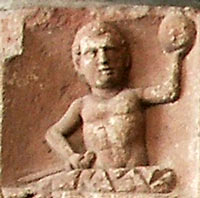
Rock-born Mithras holds aloft the world, a dagger at the ready.
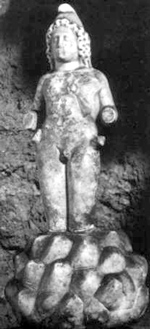
Petra Genetrix (“the rock that gives birth”).
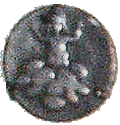
Roman silver token/coin showing birth of Mithras.
On the reverse of the coin Mithras is linked with the creator god Ormzad (another name for Ahura Mazda) and the Egyptian sun god Re.
(Verulamium, England, 2nd-3rd century)
The rock connection of Mithras would find its Christian counterpart in the later legend of Saint Peter. The 4th century Christian and astrologer Firmicus also drew a connection with Christ himself:
“Another pagan sacrament has the key word theos ek petras (“god from rock“) … Different is the stone which God promised … What the symbol of the worshipful stone means to us is Christ. Why do you with the knavery of a thief transfer to superstitions the dignity of a worshipful name?“
– Firmicus Maternus, The Error of Pagan Religions, 20.1.
Mithras – an exemplar for his followers
Mithras, a god who came to earth, showed his valour and tenacity by first capturing and then confining to his cave the first creature. The scene is a primordial age (“in the beginning“) and the only, “first begotten“, creature is a primordial bull, progenitor of an animal revered widely around the ancient Mediterranean for its strength and virility. At one point in this episode Mithras is dragged off by the rampaging bull but the god prevails and provides an example to his votaries of “difficulties overcome”.
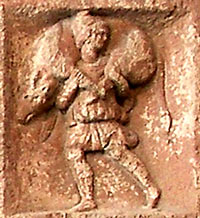
Mithras captures and carries away the defeated bull on his shoulders, just as a “good shepherd” might carry a sheep.
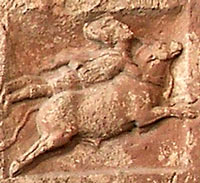
The bull puts up a struggle and Mithras engages in a fierce running fight.
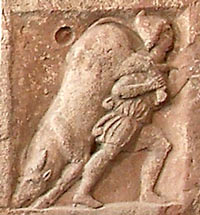
Mithras wins the struggle and drags the bull by its hind legs to the cave where it will be slaughtered.
The Passion – “Tauroctonous Mithras”
The striking image of the Mithras sacrificing the bull, the tauroctony, survives in more than seven hundred examples. Although not always obvious, the killing scene is set within a cave, which is also the interior of the cosmic egg (the whole universe). The sungod Mithras proves himself the “saviour of mankind“. By sacrifice, the rock-born yet humanoid Mithras saves humanity but it was not Mithras himself who dies but the mighty animal. Through the bull’s ritualistic sacrifice, from its blood and semen, Mithras is able to rejuvenate the world for the benefit of mankind.
Top left
The sun god Sol, a nimbus about his head, sends another ray towards Mithras.
A raven – the messenger – looks on.
Mithras. his cloak billowing, looks heavenward, over his shoulder towards Sol.
From the dying bull’s tail emerges ears of wheat, a symbol of rebirth.
A scorpion takes hold of the bulls testicles. The bull’s semen and blood will rejuvenate the world.
A crested snake moves in, symbol of fertile nature or perhaps, as in
Zoroastrianism, a creation of the evil spirit and competing with the dog for the life-giving blood.
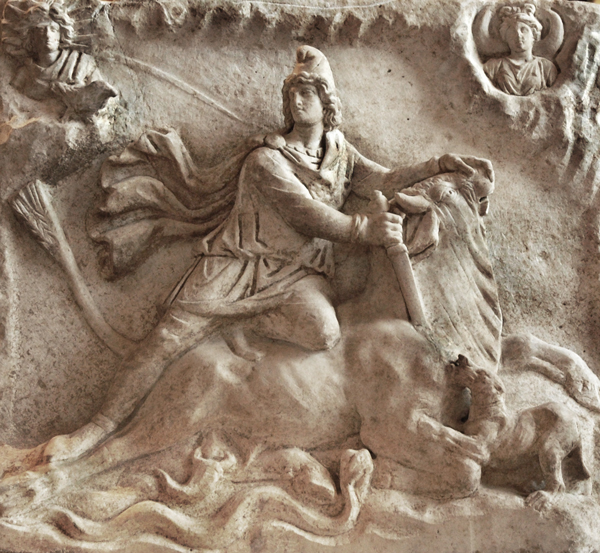
Tauroctony, Fiano Romano, near Rome (CIMRM 641, 2nd-3rd century, Louvre).
It appears that the first tauroctonous Mithras was sculpted at Pergammon, where the Asiatic god was given a more Hellenistic form.
Top right
The moon god Luna, a crescent moon behind her, looks down.
Mithras, dressed in his distinctive Phrygian hat, tunic and flowing cape, grasps the bull by the nostrils.
The bull is stabbed in the throat (or if you prefer, “pierced in his side.”)
A dog laps at the flowing blood.
Early Zoroastrianism held the dog to be a creature of spiritual virtue. The Avestan scriptures included injunctions (Vendidad 13, 15) for the protection and care of dogs.
The flowing, sacrificial blood gives life to the primordial earth.
Sacrifice: the Taurobolium and the Tauroctony
Mithraism had a benigh attitude towards other cults and appears to have formed a close association with the devotees of another Asiatic enthusiasm, the cult of Cybele/Attis. Both devotions had a central drama involving the sacrifice of a bull. But the two cults were substantially different in character and practice. Worship of Mithras was a “mystery religiion”, exclusive to male initiates and conducted out of the public gaze, whereas worship of Magna Mater was a state-sponsored and inclusive public cult.
For Mithraism, the Tauroctony (“bull slaying”) was an elaborate mystical image symbolising the “mysteries” of Mithras and was never – as far as the evidence suggests – acted out. For one thing, the subterranean Mithraic chapels were too small to accommodate the slaughter of an actual bull. Sacramental meat, however – prepared elsewhere – was consumed in the chapels of Mithras at a “Lord’s supper” and perhaps the link with the cult of Magna Mater proved useful here. In Ostia, and probably elsewhere, the temple of Cybele, the sanctuary of Attis and a mithraeum stood adjacent to each other.
The symbolic sacrifice at the heart of of Mithraism was very similar to the actual bull slaying performed in the festival of Magna Mater, the Taurobolium (“bull sacrifice”); in fact, the idea of ritualised bull slaughter may have passed from the secret ceremonies of Mithraism into the coarser public ceremonies of Magna Mater and given a new reality.
By tradition, the priests of Cybele/Attis castrated themselves. A natural development over time was the substitution of an animal for the heroic sacrifice. In any event, the bloody rite of castration – a motif that regularly appears in the artwork of Mithraism, where a scorpion performs the act – was performed on a hapless bull in the Cybele/Attis cult. One inscription, from the 2nd century, notes that the testicles of a bull removed in Rome were dedicated on the altar of a taurobolium at Lugdunum in Gaul – a gift that doubtless delighted the locals!
Mithras performs wonders – the Miracle of Water
We have evidence that Mithras performed at least one miracle: the god released life-giving water from a rock by firing an arrow. Regurgitated in the story of Jesus, the god of the Christians claimed himself to offer, or even be “living water”: “All who drink once of the water that I will give them shall never thirst anymore. “– John 4.14.
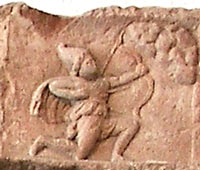
In this example of the water miracle from Neuenheim (Germany) Mithras crouches on one knee and releases an arrow.
Judaism’s priests fantasized a similar idea:
” ‘Strike the rock, and water will come out of it for the people to drink.’ So Moses did this in the sight of the elders of Israel.” – Exodus 17.6.
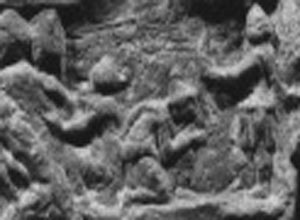
In this relief of the water miracle from Osterburken (Germany), one witness examines the rock from which the water emerges; another kneels in homage to Mithras.
Inscriptions in the Mithraeum beneath the church of Santa Prisca, Rome, identify the two witnesses as Cautes and Cautopates.
A Last Supper
“Devilish imitation of the Eucharist”
Early Christian critics of Mithraism resentfully acknowledged that the Mithraists had their own eucharist or Lord’s Supper:
“Jesus took bread, and when He had given thanks, said, “This do ye in remembrance of Me, this is My body”; and that, after the same manner, having taken the cup and given thanks, He said, “This is My blood”; and gave it to them alone. Which the wicked devils have imitated in the mysteries of Mithras, commanding the same thing to be done. For, that bread and a cup of water are placed with certain incantations in the mystic rites of one who is being initiated, you either know or can learn.“
– Justin Martyr, First Apology.
Sunday (Dies Solis or day of the sun) was kept holy in honour of Mithras. On this day, initiates of Mithraism emulated the “last supper” of their Lord by sharing a communal sacred meal. They ate bread, perhaps in the form of “hot cross buns” (see below), washed down with haoma – medicinal plant juice – or a wine substitute. Along with the food they ingested supposed “supernatural virtue”.
After the sacrifice comes the sacred banquet (“last supper”).
Sol now joins Mithras to feast on the carcass. Luna looks away.
In his left hand Mithras holds a torch, and in his left hand Sol holds a whip (by which he drives his chariot across the heavens).
The torchbearer offers a drinking horn to Sol.
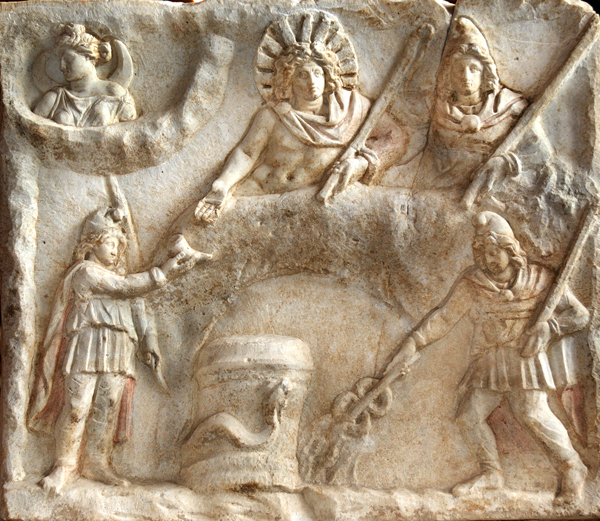
From the ground emerges water which the torchbearer gathers with a caduceus.
A snake is coiled around an altar.
From sacrifice, blood and water mankind is “saved”.
Reverse of the Mithraic relief shown above.
“Do this in memory of me” – the Eucharist of Mithras
In emulating their Lord’s “last supper” and eating the flesh of the slain bull, the initiates of Mithras could “cheat death” and emerge alive from battle.
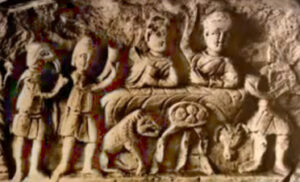
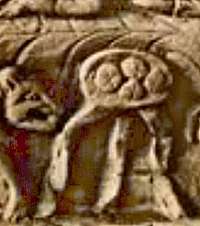
Close-up:
Note that the three-legged table holding the bread – hot cross buns?
(Konjica, Bosnia)
Mithras ascends to Heaven (and a promise of rebirth?)
With his mission accomplished, Mithras, in a chariot driven by his alter ego Sol, ascends to heaven, to rejoin the creator god Ahura-Mazda. An inscription in the Mithraeum beneath the church of Santa Prisca, Rome, though badly deteriorated, appears to promise that one is re-born (renatum) and created anew (creatum) in the celebrations of the Mysteries of Mithras. Another line praises Mithras for shedding the blood of the bull in terms very similar to confessions about the blood of Christ.
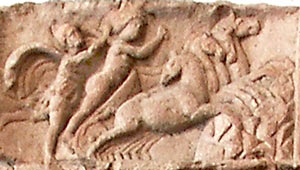
Mithra, his earthly labours over, ascends to heaven in the Sun’s chariot.
Popular motifs copied by the Christians
All this may surprise modern Christians but it was very familiar to the Church Fathers (Justin, Origen, Tertullian), who filled their ‘Apologies’ with dubious rationales as to how Mithraism had anticipated the whole nine yards of Christianity centuries before the supposed arrival of Jesus – ‘diabolic mimicry by a prescient Satan’ being the standard explanation.
“The Devil, too, baptizes some that is, his own believers and faithful followers; he promises the putting away of sins by a layer (of his own); and if my memory still serves me, Mithra there, (in the kingdom of Satan) sets his marks on the foreheads of his soldiers; celebrates also the oblation of bread, and introduces an image of a resurrection, and before a sword wreathes a crown.
What also must we say to (Satan’s) limiting his chief priest to a single marriage? He, too, has his virgins; he, too, has his proficients in continence. “
– Tertullian, The Prescription Against Heretics, XL.
The fierce Church father Tertullian also recorded that the Mithraists had their holy water which they used for spiritual purification:
“By carrying water around, and sprinkling it, they everywhere expiate country-seats, houses, temples, and whole cities: at all events, at the Apollinarian and Eleusinian games they are baptized; and they presume that the effect of their doing that is their regeneration and the remission of the penalties due to their perjuries.“
– Tertullian, On Baptism.
From the 4th century pagan emperor Julian, we learn that Mithras enjoined his followers to keep his commandments:
“As for you”, Hermes said to me, “I have granted you the knowledge of your father Mithras.
Keep his commandments, and thus secure for yourself a cable and sure anchorage throughout your life, and when you must depart from the world you can with good hopes adopt him as your guardian god.“– Julian, The Caesars.
Although we lack the fine detail, it is clear that Mithraism required both a commitment from its followers and a standard of personal conduct. In return, Mithras held out hope of the god’s help in this life and future happiness in the afterlife.
When the upstart cult of Christ forced itself onto the public stage, pagan critics were not slow to point to the truth: Christianity had simply copied the popular motifs of a competitive faith.
Sources:
Malachi Martin, The Decline & Fall of the Roman Church (Secker & Warburg, 1981)
Kevin Butcher, Roman Syria & the Near East (British Museum, 2003)
Michael Parenti, History as Mystery (City Lights, 1999)
John G. Jackson, Christianity Before Christ (American Atheist Press, 1985)
S. Angus, The Mystery Religions (Kessinger Publishing, 2003)
Antonia Tripolitis, Religions of the Hellenistic Roman Age (Eerdmans,2002)
David Ulansey, The Origins of the Mithraic Mysteries: Cosmology and Salvation in the Ancient World (OUP, 1991)
Everett Ferguson, Backgrounds of Early Christianity (Eerdmans, 2003)
Franz Cumont, The Mysteries of Mithra (1896, 1899)
Engelbert Winter, “Mithraism & Christianity in Late Antiquity”, Ethnicity & Culture in Late Antiquity (Duckworth, 2000)
Manfred Clauss, The Roman Cult of Mithras: The God and His Mysteries
Roger Beck, The Religion of the Mithras Cult in the Roman Empire: Mysteries of the Unconquered Sun (OUP, 2007)
Roger Beck, “The Mysteries of Mithras: A New Account of their Genesis”, The Journal of Roman Studies, Vol. LXXXVIII, (1998)
G. R. S. Mead, The Mysteries of Mithra (Theosophical Publishing Society, 1907)
Porphyry, De astro nymphorum (On the cave of the nymphs)
History Hunters
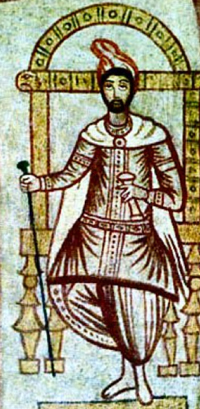
A bishop for Mithras
Fresco, mithraeum Dura-Europus, mid-3rd century.
Priest of Mithras, holding a scroll (of lost scripture?).
With his Phygian cap and cloak, the Mithraic priest anticipated the pontificals of the Catholic clergy.
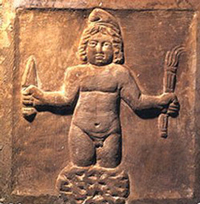
Birth of Mithras, this time with dagger and torch.
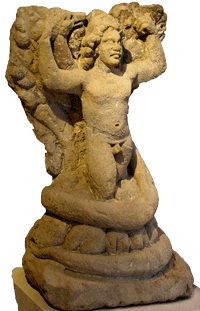
Birth of Mithras, entwined by the serpent (Altenburg, Germany)
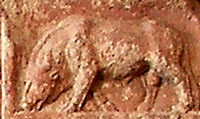
In the Beginning
In the gospel of Mithras the “first begotten” creature is the primordial bull. Mithras is born to shed its blood and save mankind.
(Neuenheim, Germany)
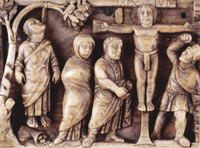
And Jesus? Compare and Contrast
For centuries Christian art avoided any depiction of the crucifixion. This earliest known example is a panel on a small ivory casket from the 5th century.
(British Museum)
Oaths?
“When a certain Omisus brought him [Artaxerxes] a single pomegranate of surpassing size, he said: “By Mithra, this man would speedily make a city great instead of small were he entrusted with it.”
– Plutarch, Life of Artaxerxes (II) (404-358 BC).
And Jesus? Compare and Contrast
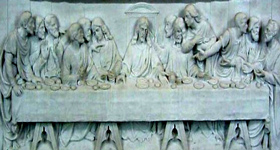
Ever wondered why JC and all twelve apostles sat on the same side of the table?!
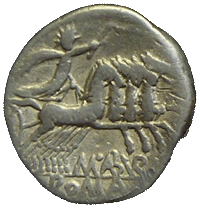
Sol drives his quadriga across the sky.
(Coin from the republican period).
